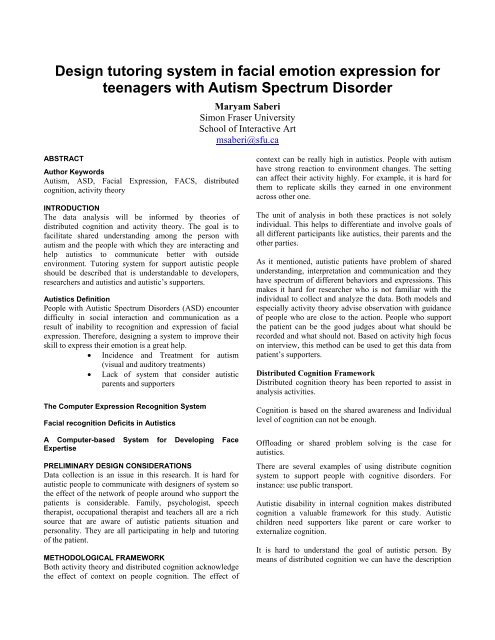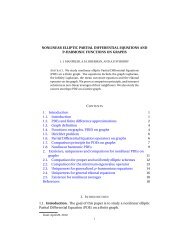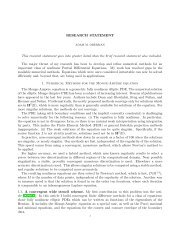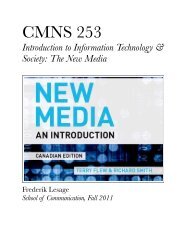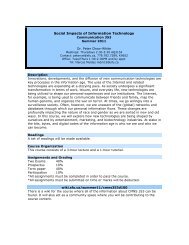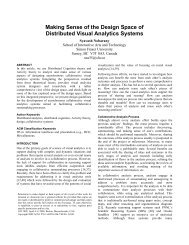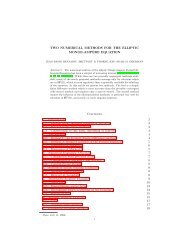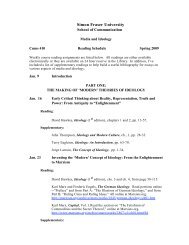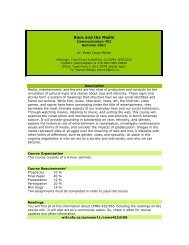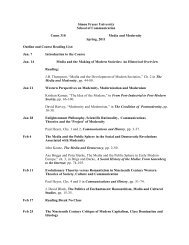PaperOutline_MaryamS.. - SFU Wiki - Simon Fraser University
PaperOutline_MaryamS.. - SFU Wiki - Simon Fraser University
PaperOutline_MaryamS.. - SFU Wiki - Simon Fraser University
You also want an ePaper? Increase the reach of your titles
YUMPU automatically turns print PDFs into web optimized ePapers that Google loves.
Design tutoring system in facial emotion expression forteenagers with Autism Spectrum DisorderMaryam Saberi<strong>Simon</strong> <strong>Fraser</strong> <strong>University</strong>School of Interactive Artmsaberi@sfu.caABSTRACTAuthor KeywordsAutism, ASD, Facial Expression, FACS, distributedcognition, activity theoryINTRODUCTIONThe data analysis will be informed by theories ofdistributed cognition and activity theory. The goal is tofacilitate shared understanding among the person withautism and the people with which they are interacting andhelp autistics to communicate better with outsideenvironment. Tutoring system for support autistic peopleshould be described that is understandable to developers,researchers and autistics and autistic’s supporters.Autistics DefinitionPeople with Autistic Spectrum Disorders (ASD) encounterdifficulty in social interaction and communication as aresult of inability to recognition and expression of facialexpression. Therefore, designing a system to improve theirskill to express their emotion is a great help.• Incidence and Treatment for autism(visual and auditory treatments)• Lack of system that consider autisticparents and supportersThe Computer Expression Recognition SystemFacial recognition Deficits in AutisticsA Computer-based System for Developing FaceExpertisePRELIMINARY DESIGN CONSIDERATIONSData collection is an issue in this research. It is hard forautistic people to communicate with designers of system sothe effect of the network of people around who support thepatients is considerable. Family, psychologist, speechtherapist, occupational therapist and teachers all are a richsource that are aware of autistic patients situation andpersonality. They are all participating in help and tutoringof the patient.METHODOLOGICAL FRAMEWORKBoth activity theory and distributed cognition acknowledgethe effect of context on people cognition. The effect ofcontext can be really high in autistics. People with autismhave strong reaction to environment changes. The settingcan affect their activity highly. For example, it is hard forthem to replicate skills they earned in one environmentacross other one.The unit of analysis in both these practices is not solelyindividual. This helps to differentiate and involve goals ofall different participants like autistics, their parents and theother parties.As it mentioned, autistic patients have problem of sharedunderstanding, interpretation and communication and theyhave spectrum of different behaviors and expressions. Thismakes it hard for researcher who is not familiar with theindividual to collect and analyze the data. Both models andespecially activity theory advise observation with guidanceof people who are close to the action. People who supportthe patient can be the good judges about what should berecorded and what should not. Based on activity high focuson interview, this method can be used to get this data frompatient’s supporters.Distributed Cognition FrameworkDistributed cognition theory has been reported to assist inanalysis activities.Cognition is based on the shared awareness and Individuallevel of cognition can not be enough.Offloading or shared problem solving is the case forautistics.There are several examples of using distribute cognitionsystem to support people with cognitive disorders. Forinstance: use public transport.Autistic disability in internal cognition makes distributedcognition a valuable framework for this study. Autisticchildren need supporters like parent or care worker toexternalize cognition.It is hard to understand the goal of autistic person. Bymeans of distributed cognition we can have the description
of cognitive system’s properties without need to considerthe process that is inside head of individuals.Autistic’s lack of theory of mind: Autistics may believe thatcognition system largely include their own cognition andcan not understand that other people have their ownthoughts.Activity Theory FrameworkDue to different needs of autistic patients, finding thedesign that has enough interactivity to answer these needs ischallenging. Therefore there is a crucial need to considerthe close relationship between users, people around them,artifacts and environment. People’s actions change theirenvironment and this transform affect them.During data collection different prototypes and artifactshelp to extract different range of knowledge (likes anddislikes, abilities and needs) of all the users of system(autistics, different supportive groups) in different phases ofdeveloping the system can be extracted. Usually we can notget the data directly from the autistics user and we shoulduse the knowledge of supporters who are in dailyinteraction with them.Figure 1. Activity theory in design of tutoringsystem for autisticsResearcher,AutisticpatientSoftware conventionsResearcher’s teamFacial feature extraction,Expression classification toolDesign tutoring systemResearchers,developersLIMITATIONAutism has a wide range of manifestations where childrenmight display completely different patterns of behaviorfrom one to another. On the other hand, although theaccuracy of the facial expression system is quite high, itstill has some limitations which affect the system output. Inorder to have a valid output, the software users should sitcompletely in front of camera and their face should not becovered by their hand or clothes. In addition, bad designcan frustrate the patient and even can include misleadingclues so the comprehensive set of investigation and testshould be accomplished to prove the accuracy of thesoftware before releasing it.EVALUATIONRESULTThe result of the study addresses the several designchallenges. Following concepts should be considered whendesigning a tutoring system for children with autism. If thesystem should be a collaborative or solitary play, playingalone but in parallel to others, should it ask the patient tomove, should it offer sensory reward, does the Imitation orhaving the face of user with expression will bother the useror not.Familiarity, Choice and control, Complexity andModularity, Appearance, Behavior, Environment andcontext are other factors which need investigation. Inaddition each patient has different need and should usedifferent setting.FUTURE WORKMore accurate facial expression system, Better designthrough iterationCONCLUSIONSREFERENCES1. American Psychiatric Association (2000). "Diagnosticcriteria for 299.00 Autistic Disorder". Diagnostic andStatistical Manual of Mental Disorders (4th, textrevision (DSM-IV-TR) ed.). ISBN 0890420254.http://cdc.gov/ncbddd/autism/hcp-dsm.html. Retrieved2009-09-10.2. Levy SE, Mandell DS, Schultz RT (2009). "Autism".Lancet 374 (9701): 1627–38. doi:10.1016/S0140-6736(09)61376-3. PMID 19819542.3. Johnson CP, Myers SM, Council on Children withDisabilities (2007). "Identification and evaluation ofchildren with autism spectrum disorders". Pediatrics 120(5): 1183–215. doi:10.1542/peds.2007-2361. PMID17967920.http://pediatrics.aappublications.org/cgi/content/full/120/5/1183. Lay summary – AAP (2007-10-29).4. Collins, P., Shukla, S. and Redmiles, D. (2002)."Activity Theory and System Design: A View from theTrenches." Computer Supported Cooperative Work(CSCW) - Special Issue on Activity Theory and thePractice of Design 11(1-2): 55-80.5. Kaptelinin, V., Nardi, B. and Macaulay, C. (1999). "Theactivity checklist: a tool for representing the “space” ofcontext." Interactions 6(4): 27-39.6. de Souza, C. R. B. and Redmiles, D. F. (2003). UsingActivity Theory to Understand Contradictions inCollaborative Software Development (submitted).Automated Software Engineering, Montreal, CA, IEEEPress.7. Peter Francis,Dept of Information Systems, The<strong>University</strong> of Melbourne (2006). “Autism anddistributed cognition”
8. Ben Robins, Nuno Otero, Ester Ferrari, KerstinDautenhahn. (2003) ”Eliciting Requirements for aRobotic Toy for Children with Autism –Results fromUser Panels”. Adaptive Sytems Research Group, Schoolof Computer Science, <strong>University</strong> of Hertfordshire, U.K.9. World Health Organization (2006). "F84. Pervasivedevelopmental disorders". International StatisticalClassification of Diseases and Related Health Problems(10th ed. (ICD-10) ed.).10. P. Ekman and W. Friesen. Facial Action CodingSystem: A Technique for the Measurement of FacialMovement. Consulting Psychologists Press, Palo Alto,1978.11. Del Giudice M, Colle L (2007). "Differences betweenchildren and adults in the recognition of enjoymentsmiles". Developmental psychology 43 (3): 796–803.doi:10.1037/0012-1649.43.3.796. PMID 17484588.12. Freitas-Magalhães, A. (2007). The Psychology ofEmotions: The Allure of Human Face. Oporto:<strong>University</strong> Fernando Pessoa Press


